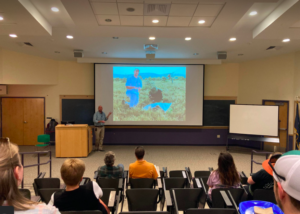University of Illinois professor visits Castleton to chat about ticks

On April 21, students and faculty welcomed Dr. Brian Allen, a reacher in the Department of Entonology at the University of Illinois, for his presentation, “The Consequences of Livestock Wildlife Integration for Tick-Borne Disease Risk in Central Kenya.”
The purpose of this lecture, held in Jeffords Auditorium, was to provide an insight into the complex nature of ranching and wildlife in this part of East Africa.
Though a majority of the audience were STEM majors, students with a variety of majors were excited to follow a discussion involving both science and economics.
Allen first explained his fascination with ticks and their potential impact on ecosystems, saying that they are “criticially important for conservation purposes.” He emphasized the difficult in managing lands in the Laikipai district of Kenya, since it is mostly private owned.
Nevertheless, Allen and his team continue to investigate the impact of ticks economically and scientifically in an attempt to improve production in cattle ranches.
Allen described ticks as the “glue that connects the entire ecosystem,” highlighting their anti-discriminatory behaviour that transmits pathogens to cattle and livestock.
Their work tested the effects of cattle and wildlife integration on tick populations by isolating various groupings over public and private ranches and wildlife conservation areas.
The experiment fascinated Petra Veljkovic, a junior molecular biology and chemistry major.
“The exclusion experimentwhere they saw the effect of cattle and wildlife and the results were like, wow! Cattle and wildlife benefit from each other!” said Veljkovic.
The study found that houing cattle and wildlife together had the optimistic impact of reducing the tick population as the cattle are treated with acaricides. Further, that cattle and wildlife do not compete aggressively over food when there was an abundance, undermining a primary concern of integrating the two groupings.
Importantly, there were no financial drawbacks from integrating the two, but rather maintained the benefit of reducing tick populations in the area.
It was this conclusion that fascinated Veljkovic, saying that the lecture was “cool from a scientific perspective, but what was even more cool was to see science come to life, and that was seen in the social aspect of his talk.”
Molecular biology major, Julia Carpented, resonated with this, saying that she “found it very interesting that cattle and wildlife live in harmony on the Laikipia Plateau.”
Students left with a greater depth of knowledge concerning tick populations in Central Kenya, but also a basket brimming with unexpected facts. Veljkovic shared her favorite, which was “of the world’s total biomass, wildlife mammals made up only only 4%!”








